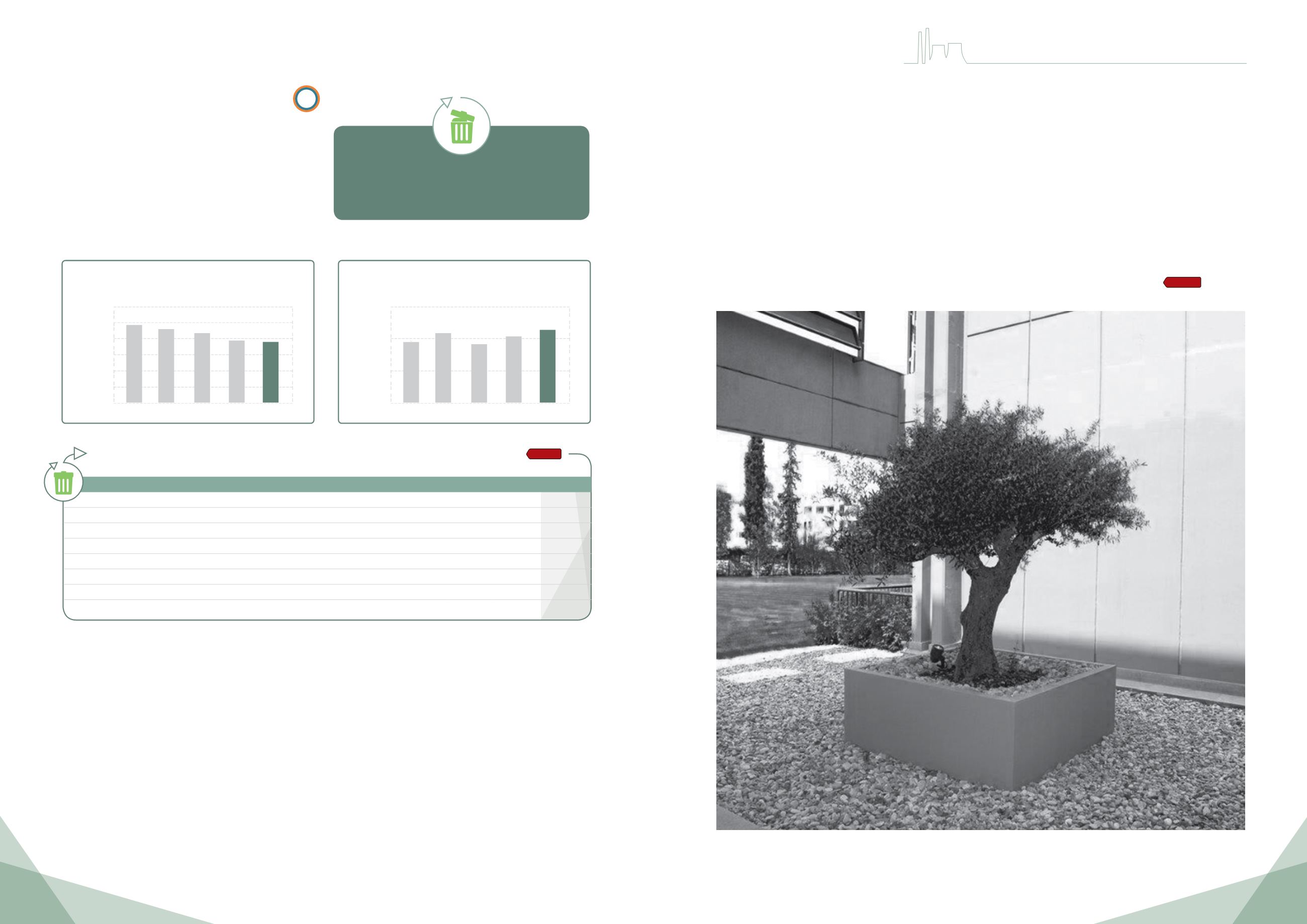
32
33
MYTILINEOS HOLDINGS SUSTAINABILITY REPORT
2015
In addition, through its subsidiary ALUMINIUMOF GREECE, the Group
participates in European research projects on cost-efficient “green”
technologies in the aluminium industry (such as “EURARE”, “Marie
Curie” and “Bravo”), aimed at the full utilisation of bauxite residues, by
submitting the relevant proposals to the competent EU committees,
and is actively pursuing the establishment of strategic partnerships
with educational and research institutions.
Waste recycling, reuse and utilisation practices are followed in all
MYTILINEOS Group subsidiaries, by means of specialised procedures
applied in the stages of production, management, collection, treat-
ment and disposal of the respective waste streams. The figure given
for waste recycling / recovery / reuse and utilisation in 2015, which
is increased by 15.5% compared to 2014, involves mainly industrial
waste as well as various types of materials collected, which include
metal scrap (e.g. iron and steel), vehicle batteries, used lubricants,
electrical and electronic equipment, paper, carton, wooden pallets,
home batteries and toner cartridges from printers and photocopiers
(643 pieces of ink cartridges and toners). Where feasible, thematerials
to be recycled are utilised inside the facilities of the Group’s subsidiar-
ies, while where waste cannot be recycled or utilised internally, this
is done through collective waste management systems or licensed
waste contractors.
Management of liquid waste and water discharges
As regards the management of the liquid waste and water dis-
charges resulting from the Group’s activity, this is done according
to the parameters determined by the environmental terms and
regulations under which the facilities of the Group’s subsidiaries
have obtained their environmental licenses.
G4-EN22
8.5 Management of solid and liquid waste
The total quantity of waste from the activities of MYTILINEOS
Group in 2015 stood at 780.969 tonnes, down by 1.7% from
2014. Of this total quantity, 93.6% comes from the Metallurgy
& Mining Sector and only 6.4% from the Group’s other activity
sectors. In terms of waste categories, non-hazardous waste was
further reduced by 2.1%, while the quantity of hazardous waste
increased by 10% due to the corresponding production increase.
Group policy on the responsible management of
w
200,000
400,000
600,000
800,000
1,000,000
1,200,000
2012
2013
2014
929,231.8
2011
982,078.6
774.786,9
2015
758.732,0
904,183.2
Non-Hazardous Waste Quantities (tonnes)
10,000
20,000
30,000
2012
2013
2014
20,952.6
2011
19,769.6
20,145.7
2015
22,237.0
19,175.2
Hazardous Waste Quantities (tonnes)
Disposal in controlled landfills refers to all hazardous waste and
aggregates and to all nonhazardous waste that were disposed
of in Controlled Landfills for Hazardous Waste and in Controlled
Landfills for Non-Hazardous Waste, respectively, by the Metallur-
gy & Mining Sector. The bauxite mining process and the produc-
tion of aluminium generate the main volume of waste. In order to
manage efficiently this waste, MYTILINEOS Group has carried out
substantial investments in the last few years, focusing on effec-
tive ways for the disposal of this waste on land, in a Group-owned
area and in accordance with the terms of a relevant environmen-
tal license, as well as on methods for its utilisation, by convert-
ing it into marketable products for sale. The improvement in this
particular area will largely depend on the utilisation of this waste
which, until final disposal, is accumulated in a special area which,
for the purposes of measuring the Group’s environmental foot-
print, is considered as a Controlled Landfill for Non-Hazardous
Waste.
The Controlled Landfill for Hazardous Waste of ALUMINIUM OF
GREECE was the first of its kind in Greece and has been in opera-
tion since 1999. The Landfill’s first 5 cells have already been rehabil-
itated, in accordance with the approved environmental terms. Today,
the Landfill’s 6th cell is in full operation and is considered a model
construction in the Greek industrial sector. Like the previous cells, it
receives waste from the aluminium (materials containing fluorides
from the reconstruction of the electrolysis basins) and alumina pro-
duction process. To address future needs, studies are underway for
the construction of the 7th cell, which, at the current waste production
rate, is expected to meet disposal needs for a period of 15-20 years of
operation.
4
7
8
15
20
23
24
26
27
29
30
28
21
10
11
22
12
13
5
2
3
18
16
6
14
19
Solid waste quantities from the Group's activities, by disposal method (tonnes)
G4-EN23
2011
2012
2013
2014
2015
Controlled Landfills for Non-Hazardous Waste
681,077.9 832,028.0 808,960.0 749,307.1
727,716.9
Recycling / Recovery / Reuse / Utilisation
91,612.4 33,252.2 72,507.0 28,107.2
32,463.7
Controlled Landfills for Hazardous Waste
16,430.3 16,997.3 19,020.0 16,043.6
17,363.2
Storage on-site
66,100.0 26,211.0
1,318.8
3,224.6
Disposal to third parties for further management or destruction
142.7
38.4
Exchange
-
-
-
-
8.46
Incineration (or use as fuel)
5.0
28.5
15.0
7.5
22.4
Uncontrolled landfills (household waste)
8.0
6.0
6.0
6.0
5.8


